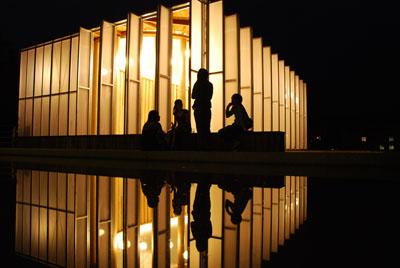Building Sustainability
Bit of a re-hash, but worth looking into associated links. Especially buildings created from wood - brilliant.
In the same way that local filter bubbles can inhibit our capacity to interact with superior internet specimens (see Eli Pariser’s TED talk from 2011), local architecture changes how we feel and behave in our neighbourhood. As anyone who has ever been a newcomer in a city, you'll have been thrown into that environment which is topologically different to before, with different microbes, smells, air currents, pollution levels, artistic inspirations. Your behaviour changes, as does your health.
Taking the example of Tirana in Albania, we find that transforming a city into one with beautiful public spaces and colourful designs reduces corruption substantially. Aesthetics – or even more fundamentally intelligent, purposeful design of our surroundings is starting to create stronger emotional connections. Incredible buildings constructed from thick paper created by architect Shigeru Ban have acted as temporary structures ranging from environmental-disaster shelters to vast churches, to the second Pompidou Centre in France. Architect Michael Green constructs with wood – finding that not only does it give us the ability to lower our carbon footprint, but people are happier and literally embrace how wood gives nature’s fingerprint to our environ. We’ve started to shift from seeing beauty as more of a stylistic mark to one combined with innovation – we want our buildings to reflect us, and thankfully, environmentally friendly architecture is growing on the agenda. With steel and concrete being the main components of current construction, they contribute 8% to total greenhouse gases, and the building industry itself almost half the total. Building from sustainable sources enables our houses to act as a carbon sink. It enables us to feel more, with our habitat forming the zeitgeist of our modern age.

Our interaction with environmental issues is increasing in cities. Introducing apps to environmental monitoring has allowed us to create pollution maps – microsensors not much larger than your smartphone allow mapping of local particulates created from expressways, dry cleaners, waste facilities and underground gas leaks. With the impact to cardiovascular and respiratory diseases such detailed knowledge can let us plan biking routes around dense areas of city pollution. Innovative designs to prevent our city becoming the smog-ridden haze that is Beijing are on the rise. UCL itself awards Small Grants challenges, which in the last year have included funding of research into infrastructure planning, building air permeability (and so CO2 emissions) and whimsical colour variation in our lighting to alter the thermal properties of housing, lowering air-con requirements.

The possibilities for developing an increasingly positive, green community in London are bright. We’ve started cycling more (the London Cycling Campaign on the 2nd Sept..did anyone go?), we can check on-the-go a company’s Material Sustainability Index using Nike, we research and develop new tools and methods, (Imperial’s student-led fuel cell/hybrid powertrain shenanigans are ones to look out for), and can use setups such as PaveGen’s footstep-to-electricity paving at West Ham tube station. For those of us keen to be part of a creative, challenging endeavour to make our city feel as incredible, cultural and crime-free as possible, we have the opportunities open to us. We just need to grasp them. We need to get creative.
As Steve Jobs said – “innovation comes from people meeting up in the hallways or calling each other at 10:30 at night with a new idea, or because they realized something that shoots holes in how we've been thinking about a problem”. There’s really no time like the present.